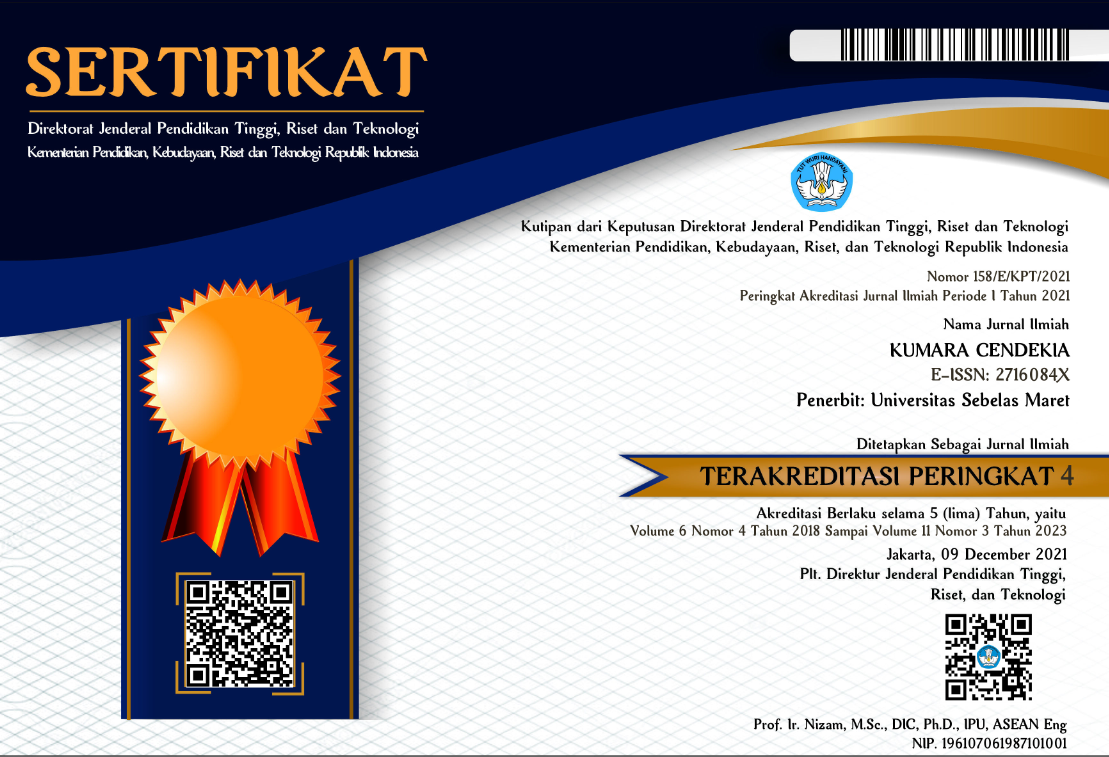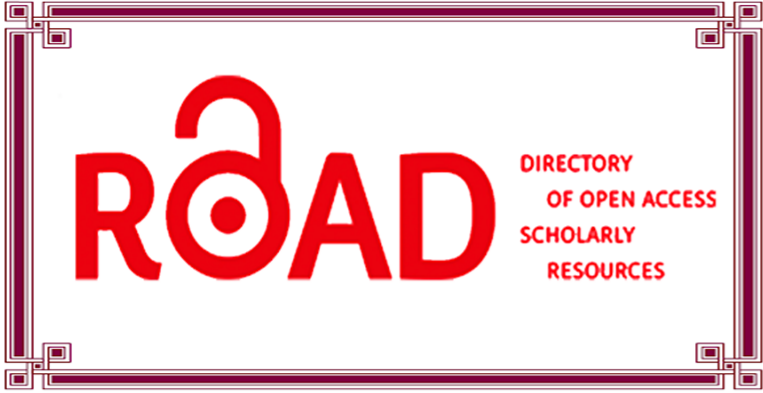METODE BERCERITA UNTUK MENINGKATKAN KECERDASAN LINGUISTIK ANAK USIA 4-5 TAHUN
Abstract
Abstrak
Penelitian ini bertujuan untuk meningkatkan kecerdasan linguistik anak usia 4-5 tahun TK Gaya Baru III Surakarta. Peningkatan kecerdasan linguistik tersebut dilakukan dengan penerapan metode bercerita melalui media diorama. Jenis penelitian yang digunakan adalah penelitian tindakan kelas dengan pendekatan kuantitatif dan kualitatif. Subjek penelitian ini adalah 16 anak kelompok A. Penelitian ini dilakukan dalam dua siklus yang terdiri dari empat kali pertemuan setiap siklusnya.. Teknik pengumpulan data yang digunakan yaitu melalui observasi, wawancara dan dokumentasi. Teknik uji validitas data yang digunakan yaitu validitas instrumen dan validitas data. Teknis analisis data kuantitatif yaitu deskriptif komparatif dan analisis data kualitatif menggunakan model interaktif. Hasil penelitian siklus I diperoleh ketuntasan mencapai 56,25% atau sejumlah 9 anak tuntas. Pada siklus II tingkat ketuntasan anak mencapai 87,5% atau sebanyak 14 anak tuntas. Peningkatan tersebut ditandai dengan keberhasilan anak dalam menceritakan kembali isi cerita dengan urut: perkenalan tokoh, waktu, tempat, menceritakan karakter tokoh, mengajukan kata tanya apa, siapa, dimana, memberikan tanggapan terhadap isi cerita dengan menjawab pertanyaan sederhana. Berdasarkan uraian diatas, hasil penelitian tindakan kelas yang dilaksanakan dapat ditarik kesimpulan bahwa melaui penerapan metode bercerita melalui media diorama dapat meningkatkan kecerdasan linguistik pada anak usia 4-5 tahun.
Katakunci: bercerita, media diorama, kecerdasan linguistik ,anak usia 4-5 tahun
Abstract
This study aimed to improve linguistic intelligence in 4-5 years old children at TK Gaya Baru III. The increase in linguistic intelligence was carried out by implementing the storytelling methods through the dioramas media. This research was carried out by using classroom action research with quantitative and qualitative approaches. The subjects of this study were 16 children of Group A. This research conducted in two cycles consisting of four meetings in each cycle.. Data collection techniques used are through observation, interviews, and documentation. The data validity test technique used is instrument validity and data validity. In analyzing quantitative data, was using descriptive comparative and qualitative data analysis was using interactive models. The results of the first cycle of research obtained completeness reached 56.25% or amount 9 children accomplished. In the second cycle, the level of completeness of children reached 87.5% or as many as 14 children accomplished. The increase could be seen by the success of the child in retelling the contents of the story in sequence, the introduction of the character, time, place, telling the character by the character, asking questions about; what, who, where, giving responses to the contents of the story by answering simple questions. Based on the description above, the results of the classroom action research carried out can be concluded that through the implementation of the storytelling method through the diorama media could improve 4-5 years old children’s linguistic intelligence.
Keywords:, storytelling, diorama media, linguistic intelligence, 4-5 years old children
Full Text:
PDF (Bahasa Indonesia)References
Daryanto. (2013). Media pembelajaran perannya sangat penting dalam mencapai tujuan pembelajaran. Yogyakarta: Gava Media
Departemen Pendidikan Nasional (2014). Permendikbud No. 137 Tahun 2014. Jakarta: Depdikbud.
Gardner, H. (2006). Multiple intelligences new horizons. New York: A Member of the Perseus Books Group
Halill, N. I. (2017).The Actualization of Literary Learning Model Based on VerbalLinguisticIntelligence.International Journal of Education & Literacy Studies, 44.
Isik, M. A. (2016). The Impact of Storytelling on Young Ages. Language and Literature Studies, 117-118.
Kumbar, R. (2006). Application of horward gardner's multiple intelligence theory for the effective use of library resources by k-2 students: An Experimented Model. 4.
Kustiawan, U. (2017). The development of diorama learning media transportation themes to develop language skill children's group B. Research on Education and Media, 28.
Mokhtar, N., Halim, A., , & Syed Kamarulzaman, S. Z. (2010). The effectiveness of storytelling in enchancing communicative skills. Procedia Social and Behavioral Science , 169.
Rahayu, A. Y. (2013). Menumbuhkan kepercayaan diri melalui kegiatan bercerita. Jakarta: Indeks.
Rahayu, S. (2017). Pengembangan bahasa pada anak usia dini. Yogyakarta: Kalimedia
Sanaky, H. A. (2013). Media pembelajaran interaktif - inovatif. Yogyakarta: Kaukaba Dipantara.
Refbacks
- There are currently no refbacks.












